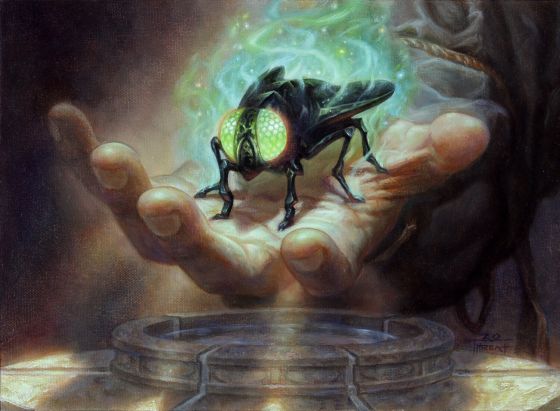Difference between revisions of "Giant Insect (spell)"
Tao alexis (talk | contribs) |
Tao alexis (talk | contribs) |
||
| Line 13: | Line 13: | ||
The caster must have a clear view of the insect to be transformed. If the insect is trapped inside a glass jar or similar containment, the spell's effect causes the insect to grow and break the container from within. The emerging gigantic insect takes no [[Damage (hit points)|damage]] if this is the case. | The caster must have a clear view of the insect to be transformed. If the insect is trapped inside a glass jar or similar containment, the spell's effect causes the insect to grow and break the container from within. The emerging gigantic insect takes no [[Damage (hit points)|damage]] if this is the case. | ||
| + | |||
| + | == Hit Dice == | ||
| + | The number of hit dice (HD) varies based on its [[Monster|monstrous]] counterpart. As an illustration, a standard [[Wasp (giant)|giant wasp]] possesses 4 HD. This number should be taken as an upward limit on the size of a transformed wasp; conversely, the smallest would have 1 HD. A caster could, therefore, create a select group of multiple wasps with varying hit dice, so long as the limit of 2 HD per level is maintained. | ||
| + | |||
| + | In determining [[Attacking in Combat|attack]] damage, for each hit die below the creature's maximum size, reduce it's maximum potential damage by one point. For instance, a conventional 4 HD giant wasp inflicts a damage range of 2-8. A like wasp with 3 HD could deal a maximum of "7" damage, which can be translated to a damage range of 2-7. A 2 HD wasp would therefore cause 1-6 damage, with a 1 HD variant dealing out 2-5. | ||
| + | |||
| + | On average, a swarm of smaller wasps would cumulatively have a potential for causing greater harm, but they would also be more susceptible to destruction by a minor spell such as [[Burning Hands (spell)|burning hands]]. Additionally, their [[THAC0|chance to hit]] a target would also be reduced. | ||
| − | |||
| − | |||
| − | |||
| − | |||
== Hostility == | == Hostility == | ||
Revision as of 16:39, 19 October 2023
Giant insect is a spell that transforms ordinary-sized insects and arachnids morphing them into giant forms. Monsters such as those detailed in the bestiary are possible, as well as others that aren't cataloged. The DM must judiciously determine the abilities and strength of enlarged creatures for which no specifications are provided.
| Range | 20 ft. |
| Duration | 2 rounds per level |
| Area of Effect | 2 hit dice per level |
| Casting Time | 2 rounds |
| Saving Throw | none |
| Level | cleric (4th) |
The caster must have a clear view of the insect to be transformed. If the insect is trapped inside a glass jar or similar containment, the spell's effect causes the insect to grow and break the container from within. The emerging gigantic insect takes no damage if this is the case.
Hit Dice
The number of hit dice (HD) varies based on its monstrous counterpart. As an illustration, a standard giant wasp possesses 4 HD. This number should be taken as an upward limit on the size of a transformed wasp; conversely, the smallest would have 1 HD. A caster could, therefore, create a select group of multiple wasps with varying hit dice, so long as the limit of 2 HD per level is maintained.
In determining attack damage, for each hit die below the creature's maximum size, reduce it's maximum potential damage by one point. For instance, a conventional 4 HD giant wasp inflicts a damage range of 2-8. A like wasp with 3 HD could deal a maximum of "7" damage, which can be translated to a damage range of 2-7. A 2 HD wasp would therefore cause 1-6 damage, with a 1 HD variant dealing out 2-5.
On average, a swarm of smaller wasps would cumulatively have a potential for causing greater harm, but they would also be more susceptible to destruction by a minor spell such as burning hands. Additionally, their chance to hit a target would also be reduced.
Hostility
Because insects lack any sort of intelligence, the caster has no control over them whatsoever. Once enlarged, they'll be furious, ravenous and bound to attack whatever target comes immediately to hand — including the caster and associated allies. Therefore steps should be taken to seek immediate cover, letting the giant insects wreak havoc and perhaps cause a distraction.
Once their usefulness is gone, the caster can dispel the effects at will, reducing any remaining insects to their normal size. If some insect becomes a danger, the dweomer can be removed from each insect individually.
Enhancing Giant Forms
The spell can be cast upon existing giant insects, in which case the original will be increased to 50% it's normal size. This effect cannot be adjusted up or down; a giant wasp will always be increased to 6 HD, with 50% more hit points. Moreover, once the spell is used in this fashion, the effect on the giant insect cannot be dispelled — if it becomes dangerous, it must be killed or suffered somehow until the spell's duration runs out.
